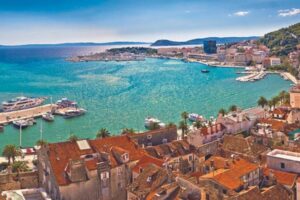Ciaran Madden
As I passed through the door of La Casa, I found myself in a dim, near-empty bar. The aroma of cigar smoke hung thick in the air. The sole patron was a heavyset middle-aged man in a white suit complete with Panama hat who looked for all the world like a Castroera Cuban official. I felt like a CIA agent on some surreptitious mission to Havana.
Except I wasn’t in Cuba at all. I was in Playa del Carmen, on Mexico’s Riviera Maya. And I wanted to pick up some Cuban cigars. Generally, I’m not a smoker, but there’s just something about the occasional Cuban…and it’s not just their superior quality. Cubans offer a novelty, an exclusivity, that other cigars lack. Forbidden fruit is always the sweetest.
However, buying genuine Cubans is a fraught business. Habanos S.A., Cuba’s global cigar distribution company, struggles to keep fakes off the market, both at home and around the world. Ramble along Fifth Avenue, Playa’s bustling central thoroughfare, and you’ll find countless street vendors, and even cigar stores, selling Monte Cristos and Cohibos, rather than Montecristos (there’s no space in the name) and Cohibas…at alarmingly cheap prices.
But I wanted the real deal, so I went straight to the source (or as direct as you can get outside of Cuba): the quasi-official La Casa del Habano. La Casas are franchised outlets overseen by Habanos. The first La Casa opened in Cancún, in 1990. Today, there are over 100 outlets all over the world.
Back in La Casa, when I inquired about buying some Cubans, the bartender nodded and led me to a sealed room at the rear. It was noticeably cooler in here; misting machines worked hard to protect the cigars from the oppressive heat. Though small, the humidor was impressively stocked, including several special editions available only at authentic La Casa outlets.
I purchased some Montecristo No. 2s, the signature Cuban cigar, as well as a few Romeo y Julieta Wide Churchills. Though the bill ran into the hundreds of dollars, when it comes to buying Cubans, it’s worth it to know that you’re getting genuine cigars that would pass the Castro taste test. You’ll find La Casa del Habano on 5th Avenue, between Calle 40 and 42.
Cut Your Customs Time With This App

With the new Mobile Passport Check (MPC) app, you can streamline your entry into the U.S for a smooth and secure arrival. Download the app onto your phone (it’s available on Apple and Google Play), upload your relevant documentation (passport information, your picture, your arrival airport). You’ll answer a couple of questions, and the app will generate a QR code for you.
When you arrive at U.S. Customs and Border Protection, you simply present your physical passport, along with that QR code. By using the app, you’ll move to a separate processing area. This allows you to forgo all that pesky paperwork, such as a declaration form. Up to 12 members of a single family can all use the MPC account, so it’s especially helpful if you’re traveling with children.
The MPC app is free…unlike the Global Entry Program, which costs $100 for a five-year membership plan. However, the MPC app is currently available only in 31 airports and four seaports. For an exhaustive list, check: cbp.gov/travel/us-citizens/mobilepassport- control.
The Best View of Pisa’s Leaning Tower
Hidden inside a walled compound, just footsteps from the Leaning Tower, the University of Pisa Botanical Garden (Orto e Museo Botanico) is the oldest university botanical garden in Europe. Established in 1543, the garden is shaded by stately trees and dotted with handsome greenhouses, fountains, and statues. Despite being near one of Italy’s most popular—and chaotic—tourist destinations, the garden is refreshingly secluded.
My husband and I came to this green refuge to celebrate his birthday. Under the shade of a 230-year-old Magnolia tree, we enjoyed a picnic of Tuscan sandwiches and marzipan cookies with pine nuts. Afterward, we explored the grounds, which are home to about 6,000 plants from several continents. We spotted a bamboo grove, greenhouses dedicated to bananas and whimsical cacti, and a pond filled with pink lotus blossoms. From here, a chorus of frogs serenaded us. In one corner of the garden, there was even a bench with extraordinary views of Pisa’s Leaning Tower. We were astounded that no one had commandeered this front-row seat!
Beyond the garden’s flora and fauna, there’s also an on-site museum, whose façade is adorned with hundreds of seashells. Gardening enthusiasts will also love the gift shop, where you can buy seeds harvested from the garden’s centuries-old trees.
All in all, the garden is a superb place to escape the throngs of people jockeying for space by the Leaning Tower. Garden tickets are €4. See: ortomuseobot.sma.unipi. it/en—IL Contributor Tricia Mitchell
A Hop, Skip, and Jump to an Irish Island
The propellors of the small nine-passenger plane suddenly roared to life, straining to lift us up into the air and over the flat, grey expanse of Galway Bay.
Then…suddenly, seemingly just as they had begun, they stopped. Not because we were falling out of the sky, but rather because we’d already touched down at our destination…Inis Mór, the largest of the Aran Islands, just off the west coast of Ireland. The flight from the Irish mainland to the landing strip on Inis Mór takes less than 10 minutes… the third-shortest commercial flight in the world.
Our early flight had us on the island before 9 a.m. Deposited by airport shuttle in the tiny village center, we found ourselves seemingly alone on the island…no shops open, no one about. Suddenly, a man named Michael appeared out of nowhere, offering his tour van services, and within moments, we were off to explore this place of stark and rocky beauty.
From the ancient Bronze Age ring fort of Dun Aengus, the island’s highest vantage point, we stood atop the sheer Hidden inside a walled compound, just footsteps from the Leaning Tower, the University of Pisa Botanical Garden (Orto e Museo Botanico) is the oldest university botanical garden in Europe. Established in 1543, the garden is shaded by stately trees and dotted with handsome greenhouses, fountains, and statues. Despite being near one of Italy’s most popular—and chaotic—tourist destinations, the garden is refreshingly secluded.
You can see nearly the entire island (just nine miles long by three miles wide) from here, dotted with the somber ruins of centuries-old Celtic and Christian sites amidst the modern homes and businesses of about 900 inhabitants.
On this particular morning, it felt we had the entire island to ourselves, and we soon found out why. Ferries to Inis Mór from the mainland take 60-90 minutes depending on weather, landing loads of tourists on the island just a bit before noon. Just as we sat down to enjoy our lunch at the charming homestyle café at the base of Dun Aengus, the horde descended. Our quick and early flight paid off with a personal and tranquil exploration of one of the most beautiful, historical spots in Ireland.
Aer Arann Islands flies daily from Inverin (15 miles west of Galway City) and costs just €35 ($35) oneway per adult. To book tickets see: aerarannislands.ie—IL Editor Dan Prescher
PRE-PAY YOUR RENT FOR A 1-YEAR VISA
Jeff D. Opdyke

your rent in advance. ©XBRCHX/iStock
This might well be the most interesting way to legally spend a year living in Europe: Prepaying one year’s worth of rent and then applying for a temporary residency visa.
That option is available in Croatia, on the Adriatic Sea, which in recent decades has grown into one of Europe’s leading beach-vacation destinations. It’s a unique way to gain access to Europe for longer than the traditional 90-day visa.
The process is easy: Find a place to rent. Prepay one full year’s rent. Take that proof to the police in the jurisdiction where you wish to live. Bring your passport, a criminal background check, a health-insurance policy, and proof of sufficient funds (roughly $500 per month as a single person; $630 for a family of two). Pay the fee…and voila: You can live in Croatia for a year.
This visa, however, is not renewable. You must leave the country for at least 90 days after it expires, and you cannot reapply until six months and one day have passed since expiration.
So, this is not a path to residency.
Still, if all you want to do is spend a year in a beautiful country with gorgeous mountains and a picturesque coastline, and which gives you easy access to Europe, the Middle East, and North Africa, Croatia’s rental-prepayment visa is an excellent option.
Michelin-Starred Dining in Mdina

of the archipelago’s best restuarants. © GRAEMENICHOLSON/iStock
From an al fresco terrace, I have a breathtaking view of the fortified medieval walls of Mdina, the city lights twinkling and dancing in the background. I can’t help but feel like I’ve stumbled into a fairy tale. The fact that I’m dining in the luxurious confines of a 17th-century palace within the walled bastions of a city thousands of years old sure helps add to the illusion.
But it’s not just the view that’s spectacular. I’m in de Mondion, a Michelin-starred restaurant, experiencing some of the best food Malta has to offer.
Chef Kevin Bonello and Sous Chef Clint Grech have honed their skills and with over 40 years of combined experience, they create fused flavors that dance on your palate. You can order a fixed menu or go à la carte…every dish combines the best of locally sourced ingredients with superb culinary innovation. The five-course tasting menu is €105 ($105) and you can feast on Mediterranean red prawns, suckling pig, and local octopus. Their sommelier will also pair each course with a glass of wine, and you can choose wines from Malta or from around the world. The restaurant is located in the Xara Relais & Chateaux hotel. To book a table, see: demondion.xaracollection. com—IL Contributor Kathleen Evans
Consider Costa Rica’s Digital Nomad Visa

Costa Rica recently made changes to its popular retiree and investor visas that feel like negatives. New retiree and investor visa applicants are now required to pay contributions to the national health service and the national pension scheme. But you have an alternative: the country also introduced a new digital nomad visa, and attorney Roger Petersen (a regular speaker at International Living events: see his website at plawcr.com) believes anyone thinking of checking out Costa Rica as a retirement destination should consider this new visa.
With the digital nomad visa, there’s no requirement to pay into the health and pension programs as long you can prove you have a monthly income of at least $3,000. The digital nomad visa runs for a single year, but it can be extended for an additional year. Roger warns that while you don’t have to pay into the national health service, you will need a private travel insurance policy worth $50,000.
Roger says: “The digital nomad visa is a good option for those that want to come to Costa Rica and test the waters without making a full commitment to the country yet. It also makes it easier to open a bank account as you will be issued a local identification card.” And if after the two years you want to stay put, you can explore further residency visas. For more on Costa Rica’s visa options, see: intliving. com/crvisas
Strolling Through Historical Hanoi
From Lenin to bonsai to a downed B-52, Hanoi’s Ba Dinh District is one of the four original urban districts of the 1,000-year-old Vietnamese capital, and is best explored on foot. First, head to Lenin Park at the corner of Tran Phu and Dien Bien Phu streets to see Vietnam’s only remaining statue of Lenin. Across the street, Vietnam’s contentious history with its neighbors and various Western powers is on full display in the fascinating Vietnam Military History Museum. It offers enlightening exhibits about Vietnam’s wars with China, France, and the U.S.
Next stop is the centuries-old Hanoi Citadel, where rows of carefully tended bonsai trees and an imposing stone entrance mark the pathway of kings. Inside, visit the bomb shelter and wartime headquarters where Ho Chi Minh, his staff, and his generals met. Continue west past the Ho Chi Minh Mausoleum to the Ho Chi Minh Museum, where English-language displays explain Vietnam’s bloody 20th-century history.
About a 10-minute walk farther west is the B-52 Lake. You’ll pass through a peaceful residential neighborhood before arriving at a pond that has the wreckage of an American B-52 bomber jutting out from the water.
End your walking tour with dinner at 19 Ngoc Ha, Hanoi’s largest bia hoi, (which means draft beer) where you can order tasty Vietnamese food. I highly recommend the bo xao lan (fried beef with chili and lemongrass). A typical meal (with beers) costs about $8 for two people.—IL Correspondent Wendy Justice


